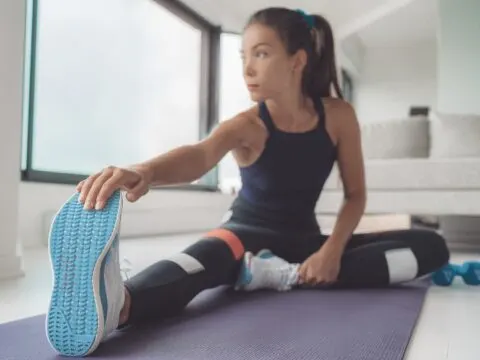Some of the links in this post are affiliate links. This means if you click on the link and purchase the item, we will receive an affiliate commission from the vendor at no extra cost to you. These business relationships allow us to keep bringing you great EatMoveHack content. All opinions remain our own.
At a Glance Info:
Targets: Hamstrings
Equipment Needed: None (though you might want a strap or a towel to help deepen some stretches)
Level: Beginner

There are things no one ever tells you about getting older, like the fact that you’ll spend three hours a day looking for the pair of glasses on top of your head or that hair will grow out of every part of your body except your scalp.
Oh, and every time you get out of a chair, your entire body will scream out in agony.
We can’t help you find your glasses or tame your body hair, but we can help make it so that you can move around freely and easily again — and it all starts with stretching your hamstrings.
Tight hamstrings are the source of a lot of physical problems, from lower back aches to knee and foot pain. If you’re an athlete (and even if you’re not), tight hammies can put you at risk of injury as well.
That’s why adding hamstring stretches to your daily routine is so important. Keeping your hamstrings limber and flexible will alleviate pressure on your spine, and that can reduce pain throughout your entire body.
It will also allow you to perform athletic endeavors — whether that’s playing full-court basketball or just sprinting to catch your toddler before they fall down the stairs — without coming up lame halfway through.
You don’t have to stretch your hamstrings, of course — but a few minutes of daily stretching is a lot easier than months of recovering from a painful injury.
What are Hamstring Stretches and What are the Benefits?
Hamstring stretches are a series of exercises aimed at reducing tension and improving both flexibility and range of motion in your hamstrings, which are the muscles at the back of your upper legs.
While hamstrings are generally referred to and treated as a single muscle, they’re actually a muscle group consisting of three separate muscles: the semimembranosus, semitendinosus, and the ischial head of adductor magnus biceps femoris. (We thought about calling this guide “How to Stretch Your Semimembranosus, Semitendinosus, and the Ischial Head of Adductor Magnus Biceps Femoris,” but we decided to just go with “hamstrings.”)
Your hamstrings are incredibly important, as you use them constantly throughout your day. They help you extend your knees while walking or running, and if they’re too tight, they can reduce the mobility of your pelvis.
This means that, for many people (especially those who sit in front of a computer all day), tight hamstrings can secretly be the cause of a lot of lower back pain. If the hamstring is pulled taut, it can create a chain reaction, throwing your pelvis, hips, and ultimately your back out of their proper posture. Many sciatica sufferers are urged to stretch their hamstrings for this very reason.
If you’re an athlete, having flexible hamstrings will go a long way towards preventing injury, especially to your knees. In any sport that requires you to put your feet on the ground with a straight leg (like soccer, football, basketball, and oh, most other sports), the hamstrings play a pivotal role in absorbing shock and ensuring proper range of motion; if they’re too tight, you could experience injuries in any of the muscles running up and down your legs.
How to Stretch Your Hamstrings Safely and Effectively
As we’ve already seen, there are actually three different muscles that make up your hamstring (don’t make us repeat them), so as you might expect, it’s hard to target them all with equal effectiveness using a single stretch. That means you’ll need to add several stretches to your routine in order to keep your hammies loose and limber.
Below are a few of our favorites. You can do them every day, or as often as you feel you need them. Don’t worry if they’re incredibly hard or if you don’t have much range of motion at first — that’s what the stretching is supposed to improve! If you’re consistent, you’ll soon find your body becoming much more flexible.
Sitting Hamstring Stretch

Call this one “Ol’ Reliable.” It’s probably the hamstring stretch you were taught to do in gym class in elementary school, and it should still be a part of your stretching routine today.
All you have to do is sit on the ground, with one leg in front of you and the other bent at the knee. Bend the leg that’s not being stretched and tuck the foot in towards the opposite knee.
Then, with a straight back, bend forward at the waist towards the outstretched leg. You can reach towards that leg with your arms (or even grab your foot), but this isn’t necessary. Remember to keep your knee slightly bent on the leg that’s being stretched.
Hold the stretch for about 30 seconds, or as long as is comfortable for you. Then switch legs and repeat.
Lying Hamstring Stretch
While you’re still on the floor, lay flat on your back. You may want to lay on a yoga mat or something else comfortable, especially if you have lower back problems.
Once you’re on your back, keep one leg flat on the floor. Take the leg that you’re going to stretch, bend it at the knee, and bring it up towards your stomach.
You should feel a light stretch as you bring the leg up, but to deepen it, straighten your knee (but don’t lock it). Ideally, the leg should be straight up in the air, perpendicular to the ground, but this takes time and practice.
Hold the stretch for 30 seconds or so, then switch legs and repeat.
This stretch is easier to do if you wrap a towel or a strap around the hamstring of the leg you’re stretching, but you can also just use your hands to pull the leg up instead (although this puts more tension on your lower back).
Wall Hamstring Stretch
This is basically a variation of the lying hamstring stretch, except you use a wall (or maybe a piece of furniture) instead of your hands or a towel.
Lay flat on your back, just like you did in the lying towel stretch (keeping one leg flat on the floor while raising the other). Put the leg that’s being stretched against a wall or the arm of your couch, then gently push.
You don’t want to push too hard, as that could lead to injury. Just a gentle, steady push — you should feel plenty of stretch in your hamstring as you do it.
As with the others, hold this position for 30 seconds or so and then switch legs.
Hamstring Stretch on Bed
This is a standing hamstring stretch, and you’ll use your bed or a similar surface to support the leg that’s being stretched.
Keep the non-stretched leg straight (but don’t lock the knee), and place the leg you’ll be stretching flat on the bed. Then, bend forward at the hips, keeping your back straight. Ideally, you’ll have your hands on your hips while you do this, but if you have balance issues you may need to use them to steady yourself.
As with the other stretches, do this for about 30 seconds and then switch.
Standing Hamstring Stretch
If you’re in a place where you can’t sit or lie down (and people would frown on you putting your feet on the furniture), don’t worry — you can still get a good hamstring stretch in.
While standing, extend the straight leg, putting the heel on a slightly raised surface like a step or a curb. Then, with a straight back, bend at the hips and bring your chest toward your thighs. You should feel the stretch in the hammy, so bend as far as is comfortable for you.
The non-stretched leg should remain straight but not locked, and you can either put your hands on your thighs or use them to hold onto something for balance.
And yep, you guessed it: hold this stretch for 30 seconds and switch.
Be careful with this stretch, though, as you can get extremely deep with it. Don’t push yourself too far too fast, and make sure you’re not going to fall over mid-stretch. If balance is an issue for you, you can also do this stretch while seated in a chair.
Seated Hamstring Stretch Using Chairs
To do this variation, you’ll need two comfy chairs. This is a great one for doing at work, especially if you’re usually sitting at a desk all day.
While seated in one of the chairs, put the other directly in front of you, far enough away that you can fully support your leg while having it extended.
Place the foot of the leg that’s being stretched on the chair while keeping your spine straight and upright. Your stretched leg should be straight, and you’ll likely feel a bit of a stretch just from doing this.
Take a deep breath, then lower your upper body towards the stretched leg. Go as far as is comfortable for you; as with the standing stretch, you can get really deep with this one, so be careful (and you may want to work up to it).
Stop immediately if you feel pain while doing this stretch, as ignoring your body’s signals could lead to serious injury. Oh, and we almost forgot — 30 seconds, then switch legs.
Common Mistakes to Avoid When Doing Hamstring Stretches
While hamstring stretches are fairly simple and straightforward, there are some mistakes that many people make when doing them. Try to avoid these, as they can either cheat you of benefits or even potentially lead to injury.
Rounding Your Back
In almost every single hamstring stretch, your upper body should remain straight. Many people round their upper back in an effort to bring their head lower and deepen the stretch, but this is the wrong way to go about it.
If you round your upper back, it tilts your pelvis and actually shortens your hamstring instead of lengthening it. This is the opposite of what we’re trying to accomplish, obviously.
Locking Your Knees
Keeping your knees locked — on either leg, but especially the one you’re stretching — also tilts the pelvis and shortens the hamstring.
Not only that, but it can put tremendous strain on the kneecap. If you push too far (or if you fall over mid-stretch), this can seriously injure your knee.
Holding Your Breath
Your muscles need oxygen to function properly, and if you put them under stress while also depriving them of air, it can compromise the effectiveness of the stretch and potentially lead to injury.
Worse still, it can make the stretch more painful (and for all the wrong reasons).

Bouncing
Many people bounce while stretching, whether to momentarily lessen the strain on the muscle or in a misguided effort to deepen the intensity of the stretch.
However, this can cause the muscle that’s being stretched to contract, which puts you at increased risk of injury. Just hold the stretch and breathe.
Not Holding the Stretch for 30 Seconds and Then Switching Sides
Sorry, we thought we’d just throw this in there one last time.
Looking for ways to improve your core, glutes, and hamstrings? Read our post on How to do Overhead Lunges Effectively.

